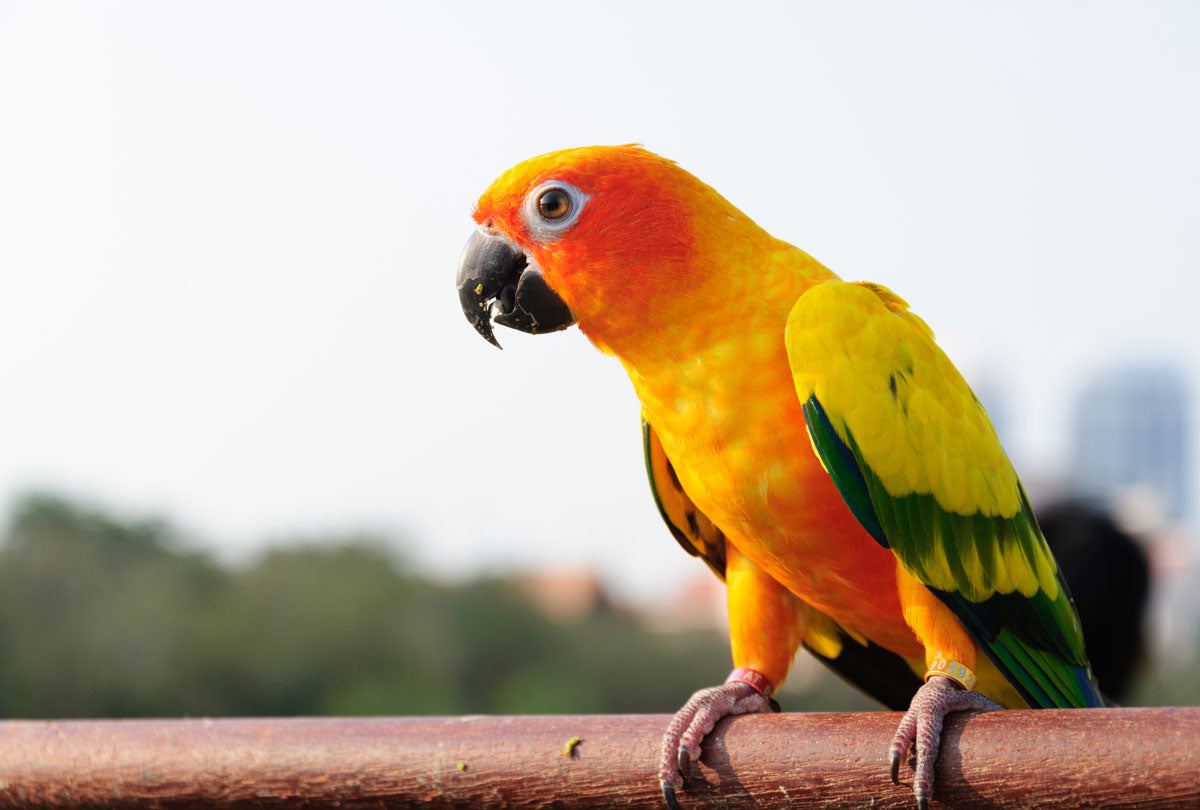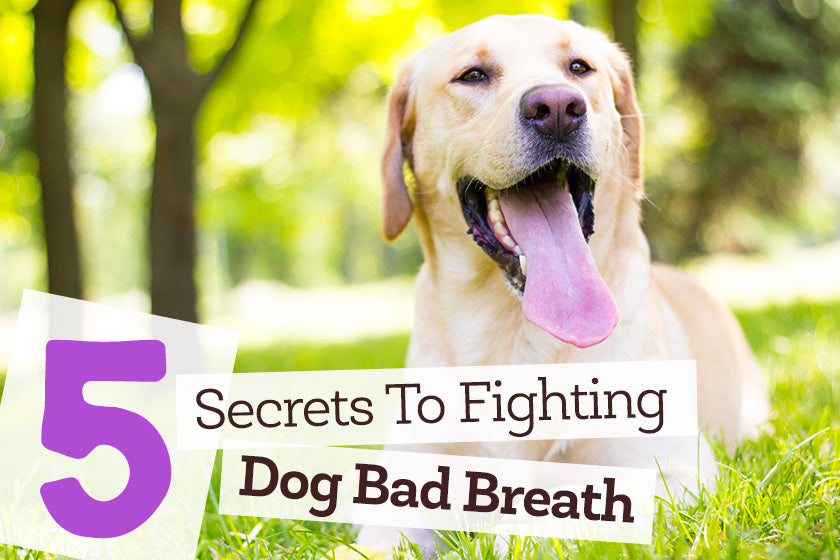Pee-yew!
If you’re constantly turning up your nose at your puppy’s bad breath, it’s time to get some help for that stinky dog breath and get back to cuddling again.
(You are, after all, the world’s best belly-rubber!)
Adopting a doggie dental routine is easier than you think. A few changes and bad dog breath will finally be a thing of the past.
So where do you start?
Lucky for you, we’ve done all the homework on better doggie breath for you … and we kept it away from Buddy and Spot so they can’t eat it!
Is Bad Breath in Dogs Serious?
Many owners are under the impression that it’s normal for their dog’s breath to smell less-than-fetching.
While your dog’s breath isn’t meant to smell like a bed of roses, it’s definitely not supposed to smell bad.
If you ignore your dog’s bad breath and hope it goes away on its own, you’re in for a rude – and stinky – awakening.
Bad dog breath is often the first sign of periodontal disease (advanced gum disease). This painful, yet completely preventable, doggie dental condition causes the gums to become red and swollen. In its later stages, the teeth separate from the gums, resulting in inevitable tooth loss.
Even more serious, bacteria from periodontal disease can spread through the bloodstream, damaging your dog’s vital organs and taking years off your pet’s life.
The Dish on Periodontal Disease
- 80 percent of dogs show signs of periodontal disease by the age of 3
- The risk of periodontal disease increases 20 percent with each year of a dog’s life
- Proper dental care could extend the life of your dog by 2–5 years
What’s the cause of bad dog breath and periodontal disease?
It all starts with plaque.
Plaque is a sticky, clear substance that gathers on the teeth after your dog eats. When plaque is left to build up on the teeth, it eventually turns into rock-hard tartar, which forms a rough surface for bacteria to grow and multiply.
Once your dog has tartar, it can only be removed through a professional dental cleaning. (Expensive!) That’s why it’s so important to keep your dog’s teeth free of plaque in the first place.
Savvy dog owners (ahem, you) will regularly inspect their dog’s mouth for signs of gum disease.
Choose a time when your dog is worn out after a long walk or play session. Face your pet and gently place one hand under the lower jaw and the other on top. Rest your hands like that for a few seconds, then work your way toward lifting your dog’s lips.
Next, take a good look at your dog’s teeth and gums. The gums should be pink, not white or red, and free of swelling. The teeth should be clean, with no brownish tartar.
Start these routine exams now. When your dog is used to having its mouth handled, this will set the stage for (gulp!) brushing.
How to Brush Away Bad Dog Breath
You don’t have to be a “Pet Whisperer” to brush your dog’s teeth. With patience and practice, you’ll be an old pro in no time. And you’ll feel great knowing that brushing is a great way to fight doggie dental disease and give your furry friend better doggie breath.
Common Dog Tooth Brushing Questions
Q: How often should I brush my dog’s teeth?
A: Daily is recommended, but life happens. If you decide a couple times a week works best, that’s good for controlling stinky dog breath.
Q: What kind of toothpaste is best?
A: Don’t reach for the toothpaste you use on your own teeth. Ingredients in human toothpaste, such as fluoride and xylitol, can make your pet sick. There are many flavored pet toothpastes, from chicken broth to peanut butter. However, many owners find that when using flavored toothpastes, their dogs don’t want to sit still for brushing. We suggest Oxyfresh Pet Toothpaste … it’s tasteless and odorless!
Q: What kind of toothbrush should I use?
A: Use a brush specifically designed for pets – they’re smaller and softer. You can find pet toothbrushes at the pet store or your veterinarian’s office. For small dogs, try a piece of clean gauze wrapped around your finger or a finger brush.
Q: How can I set us up for success?
A: Take it slow. In the days leading up to your first tooth brushing session, get your dog used to having its mouth handled. Dip your finger into broth or tuna water and let your dog lick your finger as you gently massage the teeth and gums.
7 Steps for Brushing Your Dog’s Teeth
1. Pick a time of day when your dog is mellow.
2. Gather your supplies – don’t forget treats!
3. Let your dog sniff and lick the toothpaste and toothbrush to get used to the texture.
4. Kneel or sit in front of or to the side of your dog. Don’t stand above or hold your dog down, as this type of posture is threatening. It’s also important to calmly praise your pet throughout the process.
5. Put some toothpaste on the brush. Place one hand over the top of your dog’s muzzle, then gently lift the lips. With your other hand, brush a few teeth in a circular motion at a 45-degree angle. Your pet can keep its jaws closed. Just focus on cleaning the outer surfaces of the teeth and gums. After 3 seconds, stop and release your dog’s muzzle. Reward with a treat.
Note: slowly increase the time and number of teeth you brush with each session.
6. Once you’ve mastered step 5, try gently opening your dog’s jaws to brush the back teeth. Don’t worry if it’s too hard to brush the inside of the teeth; periodontal disease is more common on the outside teeth.
7. End each session with a special reward, even if it didn’t go well. You want your dog to learn that good things always happen with brushing.
Best Chew Toys and Treats for Better Doggie Breath
As the awesome pet parent you are, you’ve likely spent a small fortune on chew toys and treats. Smart thinking …. it’s way better to have your dog chew on toys than the couch cushions!
Toys and treats prevent boredom, decrease anxiety and just feel downright good on the teeth and gums. Here’s another perk: a nice long chew is perfect for scraping away and reducing plaque.
Buyer beware! There are lots of different products on the market. And with no safety standards in place, what you don’t know could hurt your pet!
STEER CLEAR:
- Avoid treats like hard plastic bones, cow hooves, ice cubes, bully sticks and bones from steak, rib or ham shank. These can be too hard for your pet’s teeth and cause fractures.
- Cooked bones. They can splinter and cause your pet to choke.
- Abundance of table scraps. This can promote plaque buildup and cause your dog to pack on extra pounds.
- Tennis balls made specifically for pets are more likely to contain lead than “sports” tennis balls. Long-term exposure to lead can cause vomiting, weight loss and seizures in pets.
- Avoid toys treated with fire retardants or stain guard – they may contain formaldehyde and other chemicals.
- BHA is a controversial preservative found in many dog treats. The National Toxicology Program of the Department of Health and Services warns that BHA is “reasonably anticipated to be a human carcinogen” (cancer-causing agent).
RECOMMENDED:
- Knucklebones, rubber or nylon toys with a rough or bumpy surface feel great on the teeth and won’t cause fractures.
- Raw bones. They have enzymes to fight bacteria and are great to scrape away plaque.
- Dental treats that have received the Registered Seal by the Veterinary Oral Health Council (VOHC).
- Choose earth-friendly products or organic labels. These products are less likely to have toxic materials.
- Look for toys labeled BPA-free or made in the U.S. from 100% natural rubber.
Tip: Having trouble making sense of labels? Take a sniff of the toy you’re about to buy. Strong chemical smells indicate residual chemicals.
What are the most highly-rated dog treats for keeping plaque under control? Check out the list.
Is There A Way to Cure Doggie Bad Breath?
Some owners (not naming names) simply don’t want to brush their dog’s teeth for whatever reason – We totally get it!
Maybe your pet is stubborn and you’ve decided to throw in the towel. Maybe you barely have the time to brush your own teeth! It’s OK. We’re not here to judge.
We’re here for you, we have a solution for bad dog breath that does not require brushing! Oxyfresh Pet Dental Water Additive.
Just mix 1 capful of this tasteless, odorless solution into your dog’s drinking water each day to help control plaque buildup and stinky dog breath.
No Brush. No Fuss.
- Just add to your dog’s drinking water
- Non-toxic and completely safe
- Slows periodontal disease
- Neutralizes bad breath with Oxygene®
- Promotes healthy teeth & gums
Pointer: Even if you brush your pet’s teeth, Oxyfresh Pet Dental Water Additive is a great part of a daily doggie dental routine. When you add to your dog’s drinking water, fresh breath can be their constant companion!
Better Doggie Breath: Let’s Do This!
Your pet is depending on you – awesome, loyal and loving you – to make sure those teeth and gums stay healthy. So follow this ultimate guide to bad dog breath and adopt a dental routine that’s easy for both you and your pet!
Just curious. What’s the worst thing your pet has ever chewed up?




